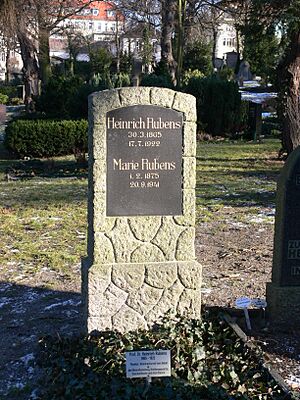Heinrich Rubens facts for kids
Quick facts for kids
Heinrich Rubens
|
|
|---|---|

Heinrich Rubens at the Solvay Conference in 1911
|
|
| Born | 30 May 1865 |
| Died | 17 July 1922 (aged 57) |
| Nationality | German |
| Alma mater | University of Berlin |
| Known for | Research in the field of Black-body radiation |
| Awards | Rumford Medal |
| Scientific career | |
| Fields | Physics |
Heinrich Rubens (born May 30, 1865, died July 17, 1922) was an important German physicist. He is famous for his work on measuring the energy of something called black-body radiation. These measurements were super important because they helped another scientist, Max Planck, discover his famous radiation law. This discovery was the very beginning of quantum theory, which changed how we understand the universe!
Rubens started studying electrical engineering in 1884. But he soon found that physics was more interesting to him. He then switched to physics at the University of Berlin. He quickly earned his doctor's degree there in 1888. From 1890 to 1896, he worked as an assistant. He became known for his amazing experiments with infrared radiation.
Contents
Early Career and Key Discoveries
In 1896, Rubens got a permanent job as a teacher at the Technical University of Berlin. This allowed him to continue his important experiments. He worked at the nearby Physikalisch-Technische Reichsanstalt. It was there, in 1900, that he made his most famous measurements of black-body radiation. This work made him known all over the world. He became a full professor that same year.
In 1906, Rubens became a professor at the University of Berlin. He also became the director of the physics institute. This meant he could guide many other scientists and students. He was elected to the Prussian Academy of Sciences and received the Rumford Medal in 1910. This award was for his research on radiation, especially very long wavelengths.
Heinrich Rubens passed away in 1922 after being sick for some time. Max Planck, the famous physicist, spoke about Rubens at a meeting. He said that without Rubens's work, the discovery of quantum theory might have happened very differently, or maybe not in Germany at all. This shows how important Rubens's experiments were! He is buried in Berlin with his wife, Marie.
Understanding Radiation: Rubens's Scientific Work
Even as a student, Rubens was fascinated by electromagnetic radiation. This is the kind of energy that includes light, radio waves, and X-rays. Scientists like Maxwell had described it with theories. Hertz had shown it existed through experiments. Rubens wanted to understand how different materials reflected or absorbed light.
In his early work, he showed that materials reflect more light as the wavelength gets longer, especially in the infrared region. Infrared radiation is the heat you feel from a warm object. He also proved that Maxwell's theories about electromagnetic waves were correct for infrared radiation. He managed to do this for wavelengths up to 10 μm (micrometers). A micrometer is super tiny, about 1/100th the width of a human hair!
Measuring Infrared Radiation
Rubens kept making his instruments better. He invented new ways to measure infrared radiation at longer and longer wavelengths. He wanted to understand how metals and crystals reflected radiation. He knew that reflection was stronger for wavelengths that were absorbed by the material.
This led him to a clever new method. He used special crystals to reflect only a very narrow range of infrared wavelengths. This technique is called Reststrahlen. In 1898, he used it to detect wavelengths around 60 μm.
The Black-Body Radiation Puzzle
That same year, Rubens teamed up with Ferdinand Kurlbaum. They started measuring the energy of black-body radiation in the far infrared region. A black body is an ideal object that absorbs all radiation that hits it. It also emits radiation based only on its temperature.
They found something surprising. For a specific wavelength, the energy of the radiation increased in a straight line with the temperature. This result did not match the Wien's radiation law, which was the leading theory at the time. However, it did match a different idea proposed by Lord Rayleigh.
The Birth of Quantum Theory
On October 7, 1900, Rubens and his wife had dinner with Max Planck. Rubens told Planck about his new measurements at a wavelength of 51 μm. After his guests left, Planck quickly worked out a new formula for radiation energy. This new formula matched Rubens's results perfectly!
Planck wrote down his new formula on a postcard and sent it to Rubens the next day. A few days later, Rubens wrote back to Planck, confirming that the new formula fit all his measurements. On December 14, Planck presented his new radiation law to the German Physical Society. He based his law on a revolutionary idea: that energy comes in tiny packets, or "quanta." This moment is often called the "birthday" of modern quantum physics.
In the years that followed, Rubens continued to improve his measurements. He reached wavelengths of several hundred micrometers. This allowed him to test Planck's new theory even more accurately. He also studied how matter behaved, which was soon explained by quantum mechanics. Rubens was well-liked by his students and colleagues. He was known for his careful and precise experimental work. In 1905, he even created a Rubens tube. This device uses a flammable gas to show how sound waves create patterns. It was inspired by his teacher's Kundt's tube, which used sand for the same purpose.
See also
 In Spanish: Heinrich Rubens para niños
In Spanish: Heinrich Rubens para niños
- Hagen–Rubens relation



